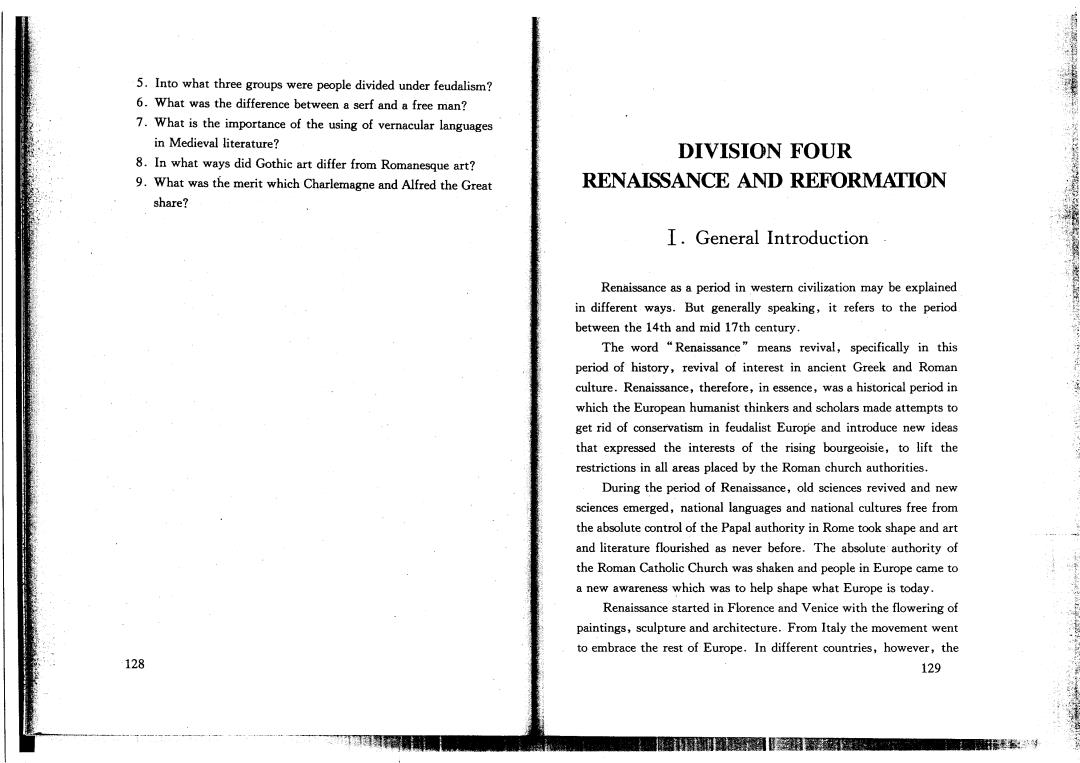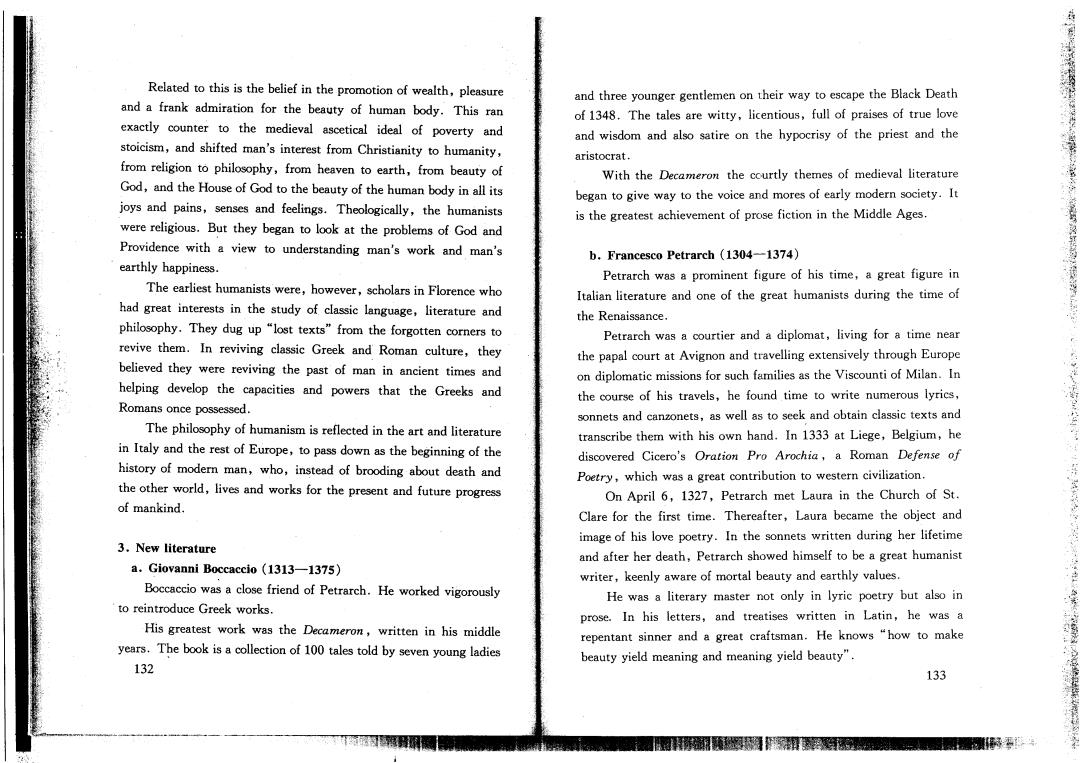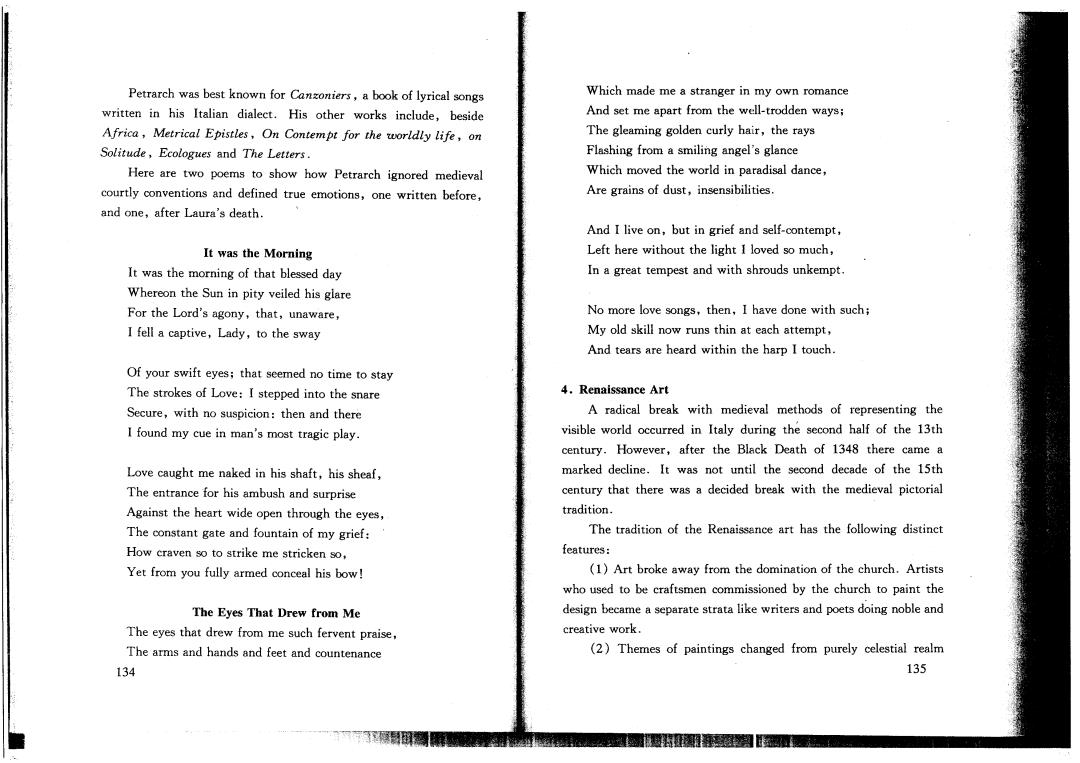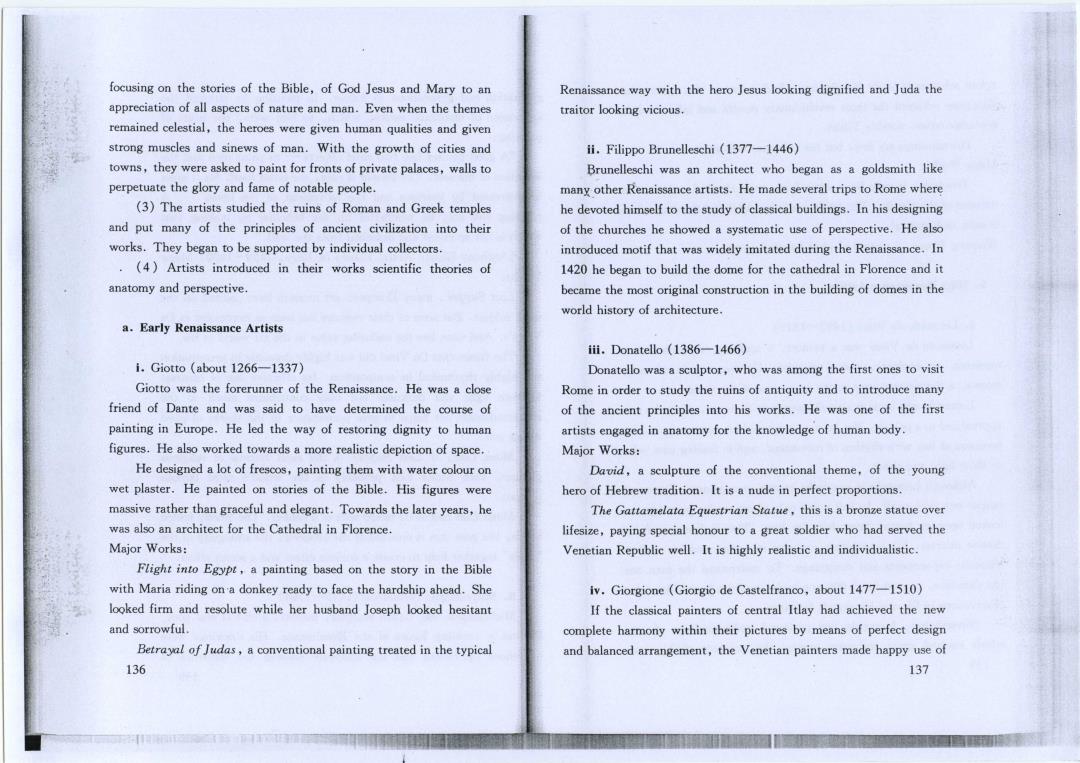
5.Into what three groups were people divided under feudalism? 6.What was the difference between a serf and a free man? 7.What is the importance of the using of vernacular languages in Medieval literature? DIVISION FOUR 8.In what ways did Gothic art differ from Romanesque art? 9.What was the merit which Charlemagne and Alfred the Great RENAISSANCE AND REFORMATION share? I.General Introduction 、 Renaissance as a period in western civilization may be explained in different ways.But generally speaking,it refers to the period between the 14th and mid 17th century. The word "Renaissance"means revival,specifically in this period of history,revival of interest in ancient Greek and Roman culture.Renaissance,therefore,in essence,was a historical period in which the European humanist thinkers and scholars made attempts to get rid of conservatism in feudalist Europe and introduce new ideas that expressed the interests of the rising bourgeoisie,to lift the restrictions in all areas placed by the Roman church authorities. During the period of Renaissance,old sciences revived and new sciences emerged,national languages and national cultures free from the absolute control of the Papal authority in Rome took shape and art and literature flourished as never before.The absolute authority of the Roman Catholic Church was shaken and people in Europe came to a new awareness which was to help shape what Europe is today. Renaissance started in Florence and Venice with the flowering of paintings,sculpture and architecture.From Italy the movement went to embrace the rest of Europe.In different countries,however,the 128 129 理糯是款:好

movement occurred in different periods with different emphasis. Where the impact with Italy was most strongly felt in fine arts,in of poets,scholars,artists and sculptors.There was in Florence a France it was literature and in England it was philosophy and drama. revival of interest in classical learning and rising of humanist ideas. And to spread the new ideas,libraries,academies were founded. Printing was invented. II.Renaissance in Italy The Renaissance reached its height in the 16th century with its centre moving to Milan,then to Rome,and created High 1.Historical Background Renaissance(1490-1530).Meantime by the beginning of the 16th century,Venetian art had come into being in full glory. Because of its geographical position,foreign trade developed early in Italy.This brought Italy into contact with other cultures and 2.The Rise of Humanism gave rise to urban economy and helped Italy to accumulate wealth As wealth grew in Italy,there grew an increasing interest in which was an essential factor for the flowering of art and literature. other pursuits.Universities,libraries,academies.were set up for Beginning from the 11th century,cities began to rise in central scholastic studies.There was time and money for things of beauty and north.Italy.But there existed rivalry among the cities and they and breaths of art. were constantly at war with each other.On top of that there were Intellectuals who used to help training priests and spreading fightings between the papacy and the emperor which kept the country doctrines of Christian faith became closely tied up with the rising divided. bourgeoisie.They provided the new moneyed class with a new As time went on,the country was divided into city-states that philosophy and culture in harmony with their needs and aspiration. were ruled by princes of commerce maintaining a delicate balance of At the heart of the Renaissance philosophy was the assertion of power between one another,and an alliance that was comparable to the greatness of man.This is best summarized in the lines of modern international relations. Shakespeare: Towards the 15th century there were among the city-states five main ones-the Duchy of Milan,the Republic of Florence and What a piece of work is man;how noble in reason;how Venice,the papal states and the kingdom of Venice.They grew infinite in faculty,in form and moving how express and prosperous under such families as the Viscounti of Milan and the admirable;in action how like an angel;in apprehension how like Medici of Florence. a god! For two centuries beginning from the late fifteenth century, Florence was the golden city which gave birth to a whole generation 130 ①Hamlet,Ⅱ.i. 131

Related to this is the belief in the promotion of wealth,pleasure and three younger gentlemen on their way to escape the Black Death and a frank admiration for the beauty of human body.This ran of 1348.The tales are witty,licentious,full of praises of true love exactly counter to the medieval ascetical ideal of poverty and and wisdom and also satire on the hypocrisy of the priest and the stoicism,and shifted man's interest from Christianity to humanity, aristocrat. from religion to philosophy,from heaven to earth,from beauty of With the Decameron the courtly themes of medieval literature God,and the House of God to the beauty of the human body in all its began to give way to the voice and mores of early modern society.It joys and pains,senses and feelings.Theologically,the humanists is the greatest achievement of prose fiction in the Middle Ages. were religious.But they began to look at the problems of God and Providence with a view to understanding man's work and man's b.Francesco Petrarch (1304-1374) earthly happiness. Petrarch was a prominent figure of his time,a great figure in The earliest humanists were,however,scholars in Florence who Italian literature and one of the great humanists during the time of had great interests in the study of classic language,literature and the Renaissance. philosophy.They dug up "lost texts"from the forgotten corners to Petrarch was a courtier and a diplomat,living for a time near revive them.In reviving classic Greek and Roman culture,they the papal court at Avignon and travelling extensively through Europe believed they were reviving the past of man in ancient times and on diplomatic missions for such families as the Viscounti of Milan.In helping develop the capacities and powers that the Greeks and the course of his travels,he found time to write numerous lyrics, Romans once possessed. sonnets and canzonets,as well as to seek and obtain classic texts and The philosophy of humanism is reflected in the art and literature transcribe them with his own hand.In 1333 at Liege,Belgium,he in Italy and the rest of Europe,to pass down as the beginning of the discovered Cicero's Oration Pro Arochia,a Roman Defense of history of modern man,who,instead of brooding about death and Poetry,which was a great contribution to western civilization. the other world,lives and works for the present and future progress On April 6,1327,Petrarch met Laura in the Church of St. of mankind. Clare for the first time.Thereafter,Laura became the object and image of his love poetry.In the sonnets written during her lifetime 3.New literature and after her death,Petrarch showed himself to be a great humanist a.Giovanni Boccaccio (1313-1375) writer,keenly aware of mortal beauty and earthly values. Boccaccio was a close friend of Petrarch.He worked vigorously He was a literary master not only in lyric poetry but also in to reintroduce Greek works. prose.In his letters,and treatises written in Latin,he was a His greatest work was the Decameron,written in his middle repentant sinner and a great craftsman.He knows "how to make years.The book is a collection of 100 tales told by seven young ladies beauty yield meaning and meaning yield beauty". 132 133 稀得

Petrarch was best known for Canzoniers,a book of lyrical songs Which made me a stranger in my own romance written in his Italian dialect.His other works include,beside And set me apart from the well-trodden ways; Africa,Metrical Epistles,On Contempt for the worldly life,on The gleaming golden curly hair,the rays Solitude,Ecologues and The Letters. Flashing from a smiling angel's glance Here are two poems to show how Petrarch ignored medieval Which moved the world in paradisal dance, courtly conventions and defined true emotions,one written before, Are grains of dust,insensibilities. and one,after Laura's death. And I live on,but in grief and self-contempt, It was the Morning Left here without the light I loved so much, It was the morning of that blessed day In a great tempest and with shrouds unkempt. Whereon the Sun in pity veiled his glare For the Lord's agony,that,unaware, No more love songs,then,I have done with such; I fell a captive,Lady,to the sway My old skill now runs thin at each attempt, And tears are heard within the harp I touch. Of your swift eyes;that seemed no time to stay The strokes of Love:I stepped into the snare 4.Renaissance Art Secure,with no suspicion:then and there A radical break with medieval methods of representing the I found my cue in man's most tragic play. visible world occurred in Italy during the second half of the 13th century.However,after the Black Death of 1348 there came a Love caught me naked in his shaft,his sheaf, marked decline.It was not until the second decade of the 15th The entrance for his ambush and surprise century that there was a decided break with the medieval pictorial Against the heart wide open through the eyes, tradition. The constant gate and fountain of my grief: The tradition of the Renaissance art has the following distinct How craven so to strike me stricken so, features: Yet from you fully armed conceal his bow! (1)Art broke away from the domination of the church.Artists who used to be craftsmen commissioned by the church to paint the The Eyes That Drew from Me design became a separate strata like writers and poets doing noble and The eyes that drew from me such fervent praise, creative work. The arms and hands and feet and countenance (2)Themes of paintings changed from purely celestial realm 134 135

focusing on the stories of the Bible,of God Jesus and Mary to an Renaissance way with the hero Jesus looking dignified and Juda the appreciation of all aspects of nature and man.Even when the themes traitor looking vicious. remained celestial,the heroes were given human qualities and given strong muscles and sinews of man.With the growth of cities and ii.Filippo Brunelleschi (1377-1446) towns,they were asked to paint for fronts of private palaces,walls to Brunelleschi was an architect who began as a goldsmith like perpetuate the glory and fame of notable people. many other Renaissance artists.He made several trips to Rome where (3)The artists studied the ruins of Roman and Greek temples he devoted himself to the study of classical buildings.In his designing and put many of the principles of ancient civilization into their of the churches he showed a systematic use of perspective.He also works.They began to be supported by individual collectors. introduced motif that was widely imitated during the Renaissance.In (4)Artists introduced in their works scientific theories of 1420 he began to build the dome for the cathedral in Florence and it anatomy and perspective. became the most original construction in the building of domes in the world history of architecture. a.Early Renaissance Artists iii.Donatello (1386-1466) i.Giotto (about 1266-1337) Donatello was a sculptor,who was among the first ones to visit Giotto was the forerunner of the Renaissance.He was a close Rome in order to study the ruins of antiquity and to introduce many friend of Dante and was said to have determined the course of of the ancient principles into his works.He was one of the first painting in Europe.He led the way of restoring dignity to human artists engaged in anatomy for the knowledge of human body. figures.He also worked towards a more realistic depiction of space. Major Works: He designed a lot of frescos,painting them with water oolour on David,a sculpture of the conventional theme,of the young wet plaster.He painted on stories of the Bible.His figures were hero of Hebrew tradition.It is a nude in perfect proportions. massive rather than graceful and elegant.Towards the later years,he The Gattamelata Equestrian Statue,this is a bronze statue over was also an architect for the Cathedral in Florence. lifesize,paying special honour to a great soldier who had served the Major Works: Venetian Republic well.It is highly realistic and individualistic. Flight into Egypt,a painting based on the story in the Bible with Maria riding on a donkey ready to face the hardship ahead.She iv.Giorgione (Giorgio de Castelfranco,about 1477-1510) looked firm and resolute while her husband Joseph looked hesitant If the classical painters of central Itlay had achieved the new and sorrowful. complete harmony within their pictures by means of perfect design Betrayal of Judas,a conventional painting treated in the typical and balanced arrangement,the Venetian painters made happy use of 136 137